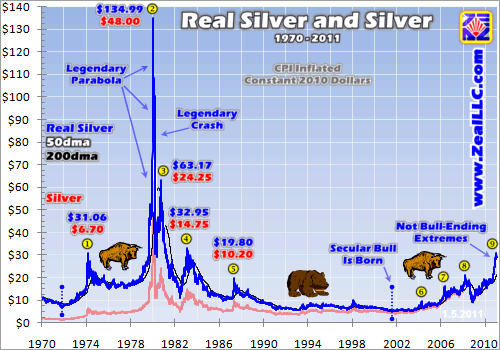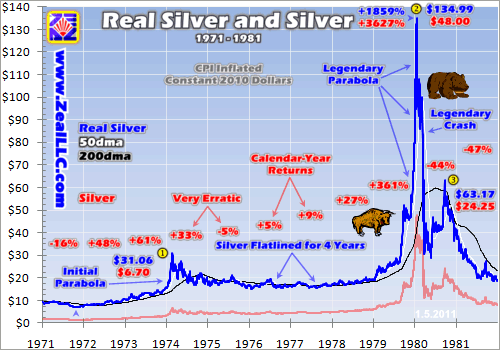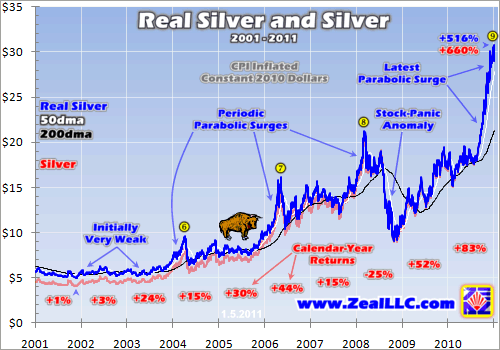|
|
|||||||
|
|
|
|
|
|
|
|
|
|
Real Silver Highs 3 Adam Hamilton January 7, 2011 2913 Words
Thanks to its awesome autumn rally, silver has become something of a rock star in the commodities world. Investors and speculators alike are enthralled with this white metal. But with it just hitting new 30-year highs, many on Wall Street suspect silver is stretching to bull-ending extremes. However once silver’s modern history is recast into real inflation-adjusted terms, this metal’s secular bull is still looking young.
For any long-term price comparisons, over a decade, adjusting for inflation is absolutely essential. The US Federal Reserve is constantly creating new fiat dollars out of thin air, cheapening all the other ones already in existence. When the money supply grows faster than the pool of goods, services, and investments on which to spend it, nominal prices rise. Relatively more dollars compete for relatively fewer things to buy, driving up prices.
You may be old enough to remember 1980, the end of silver’s last secular bull. Back when silver hit its all-time nominal (not inflation-adjusted) high of $48 per ounce, the US median household income was under $18k. Across the nation, new houses averaged just $76k while new cars ran less than $6k! A candy bar went for a quarter. Obviously a dollar back then went a lot farther than a dollar today. The Fed’s inflation since has relentlessly eroded each dollar’s real (inflation-adjusted) purchasing power.
So comparing $30 silver today to $48 silver in January 1980 is grossly misleading, it isn’t even close to being an apples-to-apples comparison. We have to adjust past prices for inflation in order to see them rendered in today’s dollars, which are the only dollars we really understand. The purest way to do this is to adjust past prices for growth in the Fed’s money supply, minus real economic growth. If money ramps by 8% and the US economy grows by 3% in any given year, then actual inflation is probably close to 5%.
But unfortunately using raw money supplies as inflation proxies is seen as too aggressive by mainstream analysts. Whenever I do analytical work, I always try to use the most conservative approach possible. That way when someone replicates my research and runs the data themselves, they actually find my numbers are quite conservative. Understating your case tends to increase your credibility.
Wall Street still believes Washington’s creative fiction known as the Consumer Price Index is the definitive inflation gauge. The CPI is horribly flawed on all kinds of fronts. It adjusts out most food and energy prices, the most important things we all buy. It uses so-called “hedonic deflators” that average away rising prices behind the facade of quality-of-life issues. For example, if a computer that once cost $3000 now costs $500, it must be 6x as useful, right? All these manipulations lowball reported inflation.
And Washington has good cause to minimize the reported CPI. Higher CPI reads scare the stock markets, leading to selloffs that agitate voters. They force the government to pay higher welfare payments which leaves less money for politicians to spend on their pet projects. They drive up interest rates, which forces Washington to pay more on its gargantuan long-term debt. They alert Americans to the predatory stealth tax on our savings that monetary inflation is. So the government wants the lowest CPI possible.
Though this index has always seriously understated true inflation in our economy, I always use it in my inflation-adjusted historical research. If I didn’t, mainstream investors and Wall Street analysts would instantly dismiss my work as radical-fringe stuff. But since the CPI is so conservative, everyone has to take real prices viewed through its lens seriously. So these silver charts are all inflated by the CPI.
While silver’s bull run since late 2001 has been impressive, when rendered in real terms it looks positively tiny compared to silver’s last secular bull in the 1970s. The blue line below is CPI-adjusted real silver, while the light-red line is raw nominal silver prices for comparison. Is $30 silver in today’s dollars super-high in historical context? Hardly! Even now this metal has only started to crawl up its real chart.
On January 21st, 1980 at its all-time high, $48 silver translates into $135 in today’s dollars. In other words, it would take $135 today to equal the purchasing power of $48 three decades ago. Per the lowballed CPI, it takes 2.81 dollars now to buy what a single dollar bought then. You can thank the Federal Reserve for this enormous stealth tax that has eroded all the capital you have saved ever since.
$30 silver today is only 22% of the way to matching its blowoff parabolic top at the end of its last secular bull in early 1980. Considered another way, silver would have to soar 350% from today’s levels before it could exceed its all-time high! So while $30 certainly feels high compared to recent years’ silver-price history, compared to the end of a mighty secular bull it is actually relatively low.
Silver stayed above $30 real more or less continuously between August 1979 and April 1981! Any price that persists for 19 months is nowhere close to being a bull-killing topping level. The popular mania that drove silver stratospheric in late 1979 saw it exceed $100 real on just 20 trading days, and it closed over $125 in today’s dollars on only 4 days. All the Wall Street arguments implying today’s $30 is so high that silver’s bull has to be over are just plain incorrect, historically myopic.
Nevertheless, silver is sure not cheap today at $30 either. By its own bull-to-date standards, silver has been super-overbought continuously since early November. It surged then when the Fed announced it was monetizing vastly more US Treasuries, or creating new dollars out of thin air to buy Washington’s debt. Being stretched so high on a short-term basis means a typical sharp silver correction is highly likely. These healthy retreats are usually big and fast, lopping 1/4th to 1/3rd off silver prices in less than 6 weeks!
So while you can’t use this long-term real chart to ignore silver’s overbought technicals, you can sure use it to show silver’s secular bull is nowhere close to extreme yet. While silver did rally 76% between July and December 2010, no mean feat, this recent upleg looked nothing like a popular-mania parabolic blowoff. Between August 1979 and January 1980, a similar 5-month span, silver skyrocketed 450% higher! There is just no possible comparison between that legendary parabola and 2010’s autumn rally.
Whenever I delve into real silver, I can’t resist looking at that 1970s superbull rendered in today’s dollars. While silver is indeed a great investment during a secular precious-metals bull, the memories of what really happened in the 1970s have been seriously distorted. Silver enthusiasts, usually inadvertently but sometimes intentionally, tend to misrepresent exactly how that last secular bull played out.
Why does silver have such a powerful allure today? One major reason is this metal soared 3627% in nominal terms between November 1971 ($1.29 per ounce, $6.89 in today’s dollars) and January 1980! A 37.3x multiplication of one’s capital, for a single trade in one secular bull, is certainly mind-blowingly epic. What investor or speculator doesn’t dream about such gargantuan returns?
Unfortunately though, the passage of time has blurred how these gains actually played out. They certainly weren’t nice and smooth, with silver rising every year like clockwork. The red percentages above, showing silver’s nominal calendar-year returns, really highlight its last secular bull’s erratic nature. Most of its entire gains were won in just two brief parabolic ascents, early 1974 and late 1979.
Due to the precious-metals summer doldrums, a phenomenon driven by the great seasonal variance in gold investment demand, silver tends to bottom in the late summer. In 1973 this low came a little late, $2.55 ($12.34 real) in mid-September. After that it was off to the races. By late February 1974, silver had soared 163% to $6.70 per ounce ($31.06 real). So by the end of that initial parabola, fully 3/4ths of silver’s entire bull’s gains to that point were won in just the final 5 months out of a 27-month bull!
One of the things all silver investors have to realize is its gains are not comfortably smooth, but highly erratic. Most happen over very-short periods of time, and then silver really tests investors’ patience by drifting listlessly for long periods of time between these spikes. After that early-1974 parabolic spike, silver flatlined for 4 to 5+ years depending on how you measure it. It didn’t again exceed February 1974’s real high until August 1979!
And then another similar big-gains streak emerged, but at a vastly larger scale. Silver bottomed at $8.74 ($25.90 real) in August 1979. Over the next 5 months it shot 450% higher to its all-time high of $48.00 ($134.99 in today’s dollars). So though silver’s famous 1970s secular bull lasted for over 8 years, a whopping 5/6ths of its entire gains accrued in just the final 5 months alone! Silver really wasn’t exciting at all for most of the 1970s, an exceedingly-important truth that is rarely considered today.
I’m a big silver fan. I first recommended physical-silver coins to our subscribers as long-term investments back in November 2001 when silver was languishing at $4.20 per ounce. In our flagship Zeal Intelligence monthly newsletter, the 48 silver-stock trades we’ve closed since 2002 have averaged annualized realized gains of +54.1%. I’ve written dozens of essays on silver and silver stocks over the last decade, helping investors and speculators win huge profits trading this volatile metal.
But silver always has been, and always will be, super-risky. Investors and speculators need to fully understand what they are getting in to. In some fringe circles, silver is venerated to the point of worship. I’ve talked with a surprising number of investors over the years who own nothing but silver, they are fanatical in their devotion. I admire their zeal and commitment, but if often leads to greatly minimizing silver’s risks while wildly overstating its potential rewards, misleading new silver investors.
Silver’s bull-market gains are spiky, fairly-rare fast surges surrounded by vast seas of long and boring consolidations. It requires a great deal of patience, and a very high tolerance for extreme volatility, to harness those episodes when silver is finally surging. You can own silver (and to a lesser extent silver stocks) for literally years without seeing anything much happen. And then the silver complex can suddenly rocket up so fast that your total gains far exceed the opportunity costs of the long wait.
Thankfully silver’s current secular bull, while still very volatile and psychologically-trying, has been much more consistent so far than its 1970s ancestor. While we still see periodic parabolic surges where all the gains happen surrounded by barren wastelands of consolidations, silver’s advance is much more evenly-paced this time around. Check out silver’s annual returns below compared to the 1970s ones above.
Silver’s 2000s secular bull has seen its characteristic parabolic surges much more often than in the 1970s. There are more spiking episodes with less consolidation time between them, a welcome change. And other than that wild stock-panic year of 2008, silver’s calendar-year returns have been much tighter and less erratic than they were in the 1970s. The standard deviation of these annual gains has plunged.
I suspect a major driver of this smoother bull run is technology, acting on silver from multiple fronts. The Internet makes it far easier for new investors to learn about silver today than in the 1970s. Back then, you either had to personally know someone who already invested in silver or subscribe to a relatively-obscure financial newsletter to get information on this metal. Today, anyone with a computer can easily learn about this silver bull, its underlying fundamentals, and how to profitably invest in it.
In addition, silver investment is far easier now thanks to technology. While I prefer physical coins personally, most investors can’t be bothered with their high transaction costs. They don’t want to search for an honorable local coin dealer, figure out what kind of silver to buy, and pay the high premiums necessary to purchase coins. For these more-mainstream investors, the SLV silver ETF has been a godsend. It gives them instant silver exposure for trivial commissions, and they can efficiently enter and exit as often as they want.
SLV was born in April 2006, with just 21m ounces of silver held in trust for its shareholders. As expected, it opened up a huge new conduit for traditional stock-market capital to flow into silver bullion. The more stock investors who buy SLV, the more silver this ETF’s custodians have to purchase to shunt this excess buying pressure directly into the underlying physical metal itself. Last month, SLV’s holdings hit a new record high approaching 353m ounces!
To put this into perspective, global silver production in 2009 ran about 700m ounces. Stock investors’ vast capital has already absorbed half a year’s worth of global silver production in the primary US silver ETF alone! This new source of capital has accelerated this silver bull while making it much more consistent than the 1970s one, because the dollar inflows are more constant. While silver is still spiky, so far it has been less so in today’s bull.
And up just 660% so far in nominal terms, today’s silver bull is nowhere near the extreme +3627% seen in the 1970s bull. This is another indication that this secular bull is much younger than Wall Street thinks. Secular bulls don’t end, and shoot parabolic, until the general public is totally enamored with their underlying assets. We certainly haven’t seen anything remotely like this in silver yet. To visualize a popular mania, think the technology stocks in late 1999 and early 2000.
Once the general public gets involved and feeds a mania, all everyone talks about is that hot asset. People who have never invested before sell stuff and mortgage their houses to raise cash to plow into the mania. Waiters and housewives and people never interested in the markets before eagerly brag about how well their new investments are doing. Today silver is nowhere close to being popular among mainstream Americans. I bet less than 10% of investors own any, let alone the non-investing public.
In real inflation-adjusted terms, $30 is simply not extreme at all. This buttresses some research I did a few weeks ago looking at silver’s “valuation” relative to gold. Interestingly at today’s gold prices, $30 silver is perfectly reasonable based on the strong historical relationship between these two precious metals. So all the Wall Street talk about silver’s bull being over because it hit 30-year nominal highs is uninformed at best. In historical context, today’s silver prices aren’t excessive at all.
That being said, silver is indeed very overbought on a short-term technical basis. A healthy pullback or correction is highly likely. Far from being a bad thing, this will create outstanding buying opportunities in silver stocks. Since silver can easily fall by a quarter or even a third in a matter of weeks, great silver stocks often plunge by half or more during the sharpest silver corrections. This leads to some the best buying opportunities, the lowest silver-stock prices, ever seen within ongoing secular silver bulls.
At Zeal we recently finished a 3-month deep-research project looking for the elite silver stocks with the best fundamental prospects. We started with the universe of nearly 100 silver stocks trading in the US and Canada, and gradually whittled this list down to our dozen favorites. Ranging from major world-class miners to small juniors with amazing projects, these elite silver stocks are likely to thrive in the years to come. We are going to buy them aggressively once silver works off today’s overbought conditions.
This entire 34-page silver-stock report, the valuable fruits of several-hundred laborious hours of expert research, is now available for purchase on our website. The price is just $95 ($75 for subscribers), and the time to learn about silver stocks is now before silver corrects. That way you will be ready to buy once silver gets technically-favorable again, and silver stocks hit bargain oversold levels. Buy your new report today!
Of course we also publish acclaimed weekly and monthly subscription newsletters for speculators and investors. Over the past decade our hard work and trading success have made these publications grow famous. They are wide-reaching, well-informed, fascinating, and honest looks at current market conditions, what is driving them, and how we can profitably trade them. Since 2001 in Zeal Intelligence, all 231 of our stock trades have averaged annualized realized gains of +47.5%! Subscribe today and start thriving!
The bottom line is despite silver’s big autumn rally, this metal really isn’t that high yet in inflation-adjusted historical context. When rendered in current dollars, silver spent 19 months above today’s levels around the end of its last secular bull. While silver certainly isn’t cheap at $30, neither is it anywhere close to bull-killing levels in real terms. An apples-to-apples comparison suggests today’s silver bull remains young.
And even if the climax of this secular bull isn’t quite as massive as the late-1970s parabola for some reason, silver still has plenty of room to run higher. It could double or even triple from here, and still not get anywhere close to its all-time real high. Based on silver’s true inflation-adjusted history, $30 is just not that big of a deal at all. Nominal price comparisons across decades are myopic and misleading.
Adam Hamilton, CPA January 7, 2011 Subscribe |
|||||||
|
|
|
|
|
|
|
|
|
|
|
|
|
|
|
|||



